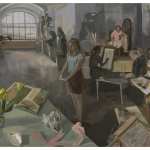A few articles this week caught my eye: an interview with Joe Bradley, a piece on a “new Rembrandt” in Amsterdam, the dirt on Trump’s art collection, Ray Johnson’s eight-year correspondence with Rauschenberg in the MoMA PS1 archives, a dissertation on Duchamp, and commentary on Lily Stockman’s abstractions in LA.
Observer reporter (and artist) Ryan Steadman interviews Joe Bradley on the occasion of “KRASDALE,” his first solo show at Gagosian. “We set a date for this show in September. I really sort of just locked myself in a room and did it. It was kind of a thrilling show to make because it�s unfamiliar territory, and I didn�t really have any idea of what it was going to look like when I began. I made some decisions about scale and material. I knew that I wanted to work with a brush [laughs]… Yeah the paintings from the last 5 years or so have been almost closer to drawing really and also�[looks to the left]�that one is going in the incinerator�Yeah, you know sometimes something just doesn�t work. I don�t know, something about it doesn�t feel correct�” Read more.
[Image at top: “Joe Bradley: KRASDALE,” installation view at Gagosian. Photo by Rob McKeever]
So LA: Sharon Mizota reviews Lily Stockman’s abstractions (image above), on view at Gavlak Gallery, in the LA Times and reveals that they were inspired by a filmmaker’s garden. “Stockman�s paintings were inspired by filmmaker Derek Jarman�s famous sustainable garden in Britain. Stockman�s vocabulary of shapes could be flower beds or abstracted body parts, or even a rudimentary alphabet. They suggest a correspondence between landscape and body in which it is hard to tease out which is which. In this sense they embody Jarman�s philosophy of gardening with, not in spite of, the natural terrain.” Read more.
A “new Rembrandt” has been created in Amsterdam (image above). According to The Guardian, a team of data scientists, developers, engineers and art historians has recreated a Rembrandt painting using 3D printing technology. “Some of the challenges have been in designing a software system that could understand Rembrandt based on his use of geometry, composition and painting materials. A facial recognition algorithm was then used to identify and classify the most typical geometric patterns used to paint human features.” I am reminded of Jurassic Park. What could possibly go wrong?? Read more.
Donald Trump’s art collection is fake? At Page Six, Richard Johnson says don’t call them fake–they are reproductions. “If Trump�s paintings were originals, his collection would be valued at hundreds of millions of dollars. Instead, they are worth little more than their ornate gilt frames. And most people have no idea they aren�t real.” Read more.
Greg.org has been “enjoying Elena Filipovic’s 2013 dissertation, whose title says it all: “The Apparently Marginal Activities of Marcel Duchamp.” [pdf via monoskop, obv]. So far it’s about photography, including a long look at the so-called Box of 1914 (1913-14), in which Duchamp made 1:1 photos of a selection of his handwritten notes.” Read more.
On MoMA PS1’s blog Inside/Out, Project Archivist Elena Cordova takes a look at the correspondence that Ray Johnson sent to Robert Rauschenberg between the years 1952 and 1965. The collection, now available online, includes small collages, newspaper clippings, postcards, and flyers. “One of the more puzzling features of this archival collection is Johnson�s pervasive use of the word ‘doublemint,’ Cordova reports. “It appears in 11 of the collection�s mailings after 1959�and yet there is no evidence that Johnson used the word in any of his other art. I was intrigued. Repetition is a common aesthetic device in modern art, but on its own this seemed far too simple an explanation. Johnson�s work may at first glance (and often at second and third glance) seem random, but his choices were rarely, if ever, arbitrary. Why, then, of all things, doublemint?” Read more.
Related posts:
Joe Bradley meets Ab Ex
Joe Bradley, Part II: A brand they can trust
——
Two Coats of Paint is licensed under a Creative Commons Attribution – Noncommercial-No Derivative Works 3.0 United States License. To use content beyond the scope of this license, permission is required.


















